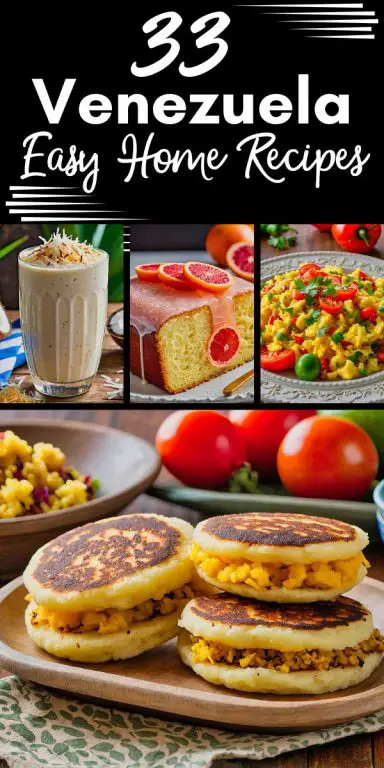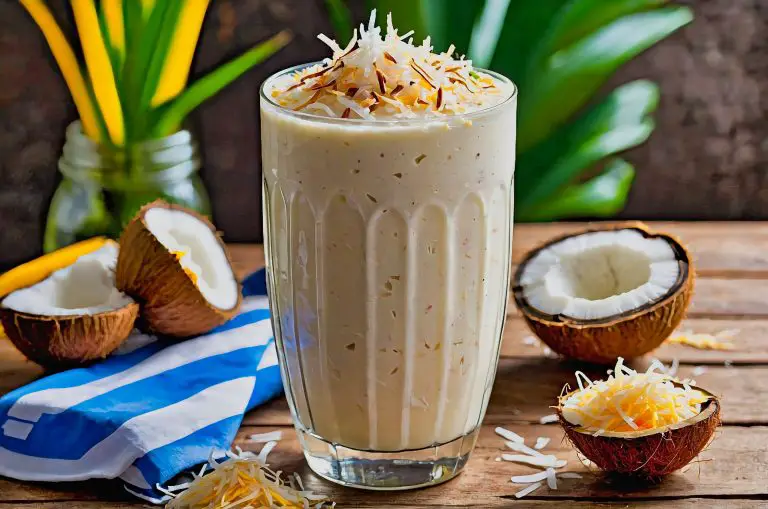Venezuela Cocada Recipe
In Cumaná in Venezuela I learned the Venezuela Cocada recipe during a cooking class. In the cooking class I learned about the Venezuela Cocada (a drink made with fresh coconut, milk and sugar). The process involved whipping up grated coconut with milk. Sweeteners were added as desired and the drink was chilled. It was easy to make and emphasised using local, fresh ingredients.
Cumaná, on the Venezuelan north coast, is one of the oldest continuously inhabited cities in South America. It has colonial architecture, markets and views of the Caribbean Sea. Attractions include the Castillo de San Antonio de la Eminencia, a historic fort overlooking the city. Another site worth visiting is the Museo Gran Mariscal de Ayacucho about the region’s history. Nearby beaches like Playa San Luis have calm waters and sandy shores.
I tried the Venezuela Cocada recipe and it was very smooth and creamy with a bit of coconut sweetness. The drink had a gentle flavor and was refreshing and filling. Locals enjoy it as a cooling beverage along the warm coastal climate. It is often found at beachside stalls and small cafes in Cumaná, served with ice for a chill.
Cumaná has more to offer visitors than food. Locals sell fresh produce, seafood and hand – made crafts at the Mercado Municipal. The city’s waterfront areas offer a relaxing atmosphere with views of fishing boats and the horizon. For nature lovers, nearby Mochima National Park offers islands, beaches and marine life.
The Venezuela Cocada recipe reflects Cumanás coastal culture with coconut being a staple ingredient in a way that demonstrates its freshness and versatility. Its popularity among locals reflects the city’s relationship with nature and availability of its ingredients. Learning to make this recipe in a cooking class was a practical and fun way to spend my visit and helped me appreciate the region’s culinary traditions.
Ingredients
Coconut
Whole Milk
Sweetened Condensed Milk
Vanilla Extract
Ice
Directions
- Throw everything into a blender: milk, sweetened condensed milk, coconut flesh, and vanilla extract, if using. Whip for approximately two to three minutes, or until the mixture is completely smooth.
- Use a fine mesh strainer to separate the ingredients. IMPORTANT NOTICE: For added texture, I prefer to add 1-2 teaspoons of coconut that has been finely strained to the strained mixture. However, this is entirely optional.
- Toss everything back into the blender and add ice cubes according to your preference. Pulse until all ice is broken up.
Take a seat. If you’d like, you can top it with cinnamon and add additional sweetened condensed milk. Let your mind go to the stunning beaches of Venezuela while you relax and enjoy.
Favorite Local Foods in Venezuela
Venezuela has a diverse and interesting food scene reflecting its history, geography and people. The local cuisine combines indigenous, African and European influences, with regional variations in flavors. From the lively streets of Caracas to the coastline and the plains, Venezuela has a food culture as varied as its landscape.
The most famous dish in Venezuela is the arepa. This versatile cornmeal cake can be grilled, fried or baked and it is served for Venezuelan breakfasts, dinners and lunches. Arepas typically contain cheese, ham, shredded beef, or chicken. Arepas are favorites everywhere in the country, whether as a quick snack or as a main meal. An example is the arepa reina pepeada, stuffed with a creamy chicken salad of avocado, mayonnaise and shredded chicken.
Another popular food in Venezuela is pabellon criollo, the national dish. Shredded beef, black beans, rice and fried plantains make this filling meal. The flavors – salty, sweet and savory – make pabell’n criollo a comfort food. In fact, it’s often served at special occasions and gatherings, as part of Venezuelan hospitality. Tender shredded beef is seasoned with a variety of spices and the beans are cooked through.
Venezuela’s tropical climate means that fresh fruits are plentiful; some of the locals favorite drinks are jugos naturales, fruit juices made from tropical fruits such as mango, guava, papaya and passion fruit. These juices are often fresh and found in homes, restaurants and street stalls. They cool off on a hot day and are a delicious symbol of Venezuela’s natural resources.
Street food is a must try if you want to try local flavors in Venezuela. Cachapas, for example, are thick corn pancakes that are usually stuffed with cheese. Made from fresh corn, cachapas are slightly sweet and savory and popular for breakfast or lunch. Yet another street food is empanadas, stuffed pastries stuffed with cheese, meat or seafood. They are deep fried and served hot with salsa de ajo (garlic sauce).
Hallacas are another traditional food associated with Christmas celebrations in Venezuela. These cornmeal parcels are full of pork, raisins, olives, chicken, beef, and capers and steamed in plantain leaves. The preparation of hallacas is a family activity and the dish has become a part of Venezuelan holiday traditions.
From the comforting pabellon criollo to the fruit juices and the arepa, Venezuelan food can be found in many flavors and textures. At home or on the streets, Venezuelan cuisine reflects the country’s culture and history.
Where to Find Local Restaurants and Diner Favorites in Venezuela
Caracas, the capital of Venezuela, offers numerous culinary delights which includes traditional Venezuelan dishes. Regardless of whether you might be a visitor attempting to try traditional Venezuelan food or a local trying to explore new dining places, knowing where to eat can mean the difference. Caracas boasts a mix of street food, classic diners and contemporary restaurants for anyone looking for true Venezuelan flavours. Understanding where you can look and the way to navigate the dining scene will help you obtain the very best dining the city is offering.
For local food to try in Caracas, head to the neighbourhoods where dining culture abounds. Areas like Chacao and Sabana Grande are full of food establishments. These neighbourhoods offer everything from small, family-owned diners serving traditional fare to hipster eateries presenting modern interpretations of Venezuelan classics. Walking through these districts is a good way to find hidden gems that locals frequent. Watch the spots that have a steady stream of patrons: Those are often the best clues to quality and authenticity.
Street food is among Caracas’ culinary traditions and also consists of several of the city’s most famous dishes. For street food vendors, go to plazas and busy avenues like Plaza Venezuela or Avenida Francisco de Miranda. Vendors of arepas, empanadas and cachapas are just some of the local fare. Asking locals which stalls are best may help you identify the best. Ask vendors or regular customers for recommendations – they often know where to get the best bites in the area.
One other way to find the best local restaurants is to find traditional Venezuelan dishes which are regional specialties. Restaurants offering pabellon criollo, asado negro and hallacas tend to use the traditional techniques and flavours. Look for spots that feature fresh, local ingredients; these tend to be quality – focused. Family-run diners and small restaurants (“comedores”) are popular in Caracas for home-style cooking.
Find great dining in Caracas using social media and online reviews. Platforms such as Instagram and Google Maps host photos, reviews and ratings from both locals and visitors alike. Look up hashtags like Venezuelan food or Caracas dining to find recommendations on everything from hidden eateries to must-try street food. Also try joining local food forums or Facebook groups to meet locals who want to share their favourite spots.
Caracas also boasts a burgeoning food tour industry to help you find local favorites. Guided tours by locals can introduce you to some of the city’s authentic dishes and give insight into the food culture. These tours often include stops at both famous and lesser-known places, so you can sample more of Caracas cuisine.
Lastly, the most effective way to discover the very best dining options in Caracas is asking locals. Venezuelans are known for their hospitality and sharing of food culture. Nearly everybody is going to tell you about their favourite restaurants or street food sellers in case you ask a taxi driver, a passerby or a shopkeeper. Trusting their suggestions often means memorable meals and real experiences.
You can find the best local restaurants and diner favourites in Caracas by wandering neighbourhoods, sampling street food and asking locals and online platforms for recommendations. The city’s vibrant dining scene provides ample opportunities to sample the varied Venezuelan cuisine.
FAQs for the Venezuela Cocada Recipe
Q: What is the Venezuela Cocada recipe and how is it prepared?
A: The Venezuela Cocada recipe is a traditional coconut dessert made with fresh grated coconut, sugar, and sometimes condensed milk. The mixture is cooked until it thickens and then allowed to set, resulting in a sweet, chewy treat enjoyed throughout Venezuela.
Q: Can I make the Venezuela Cocada recipe ahead of time?
A: Yes, you can make the Venezuela Cocada recipe ahead of time. Once the mixture is prepared and set, it can be stored in an airtight container at room temperature or in the fridge for up to a week, maintaining its sweetness and texture.
Q: Can I adjust the sweetness of the Venezuela Cocada recipe?
A: Yes, you can adjust the sweetness of the Venezuela Cocada recipe. If you prefer a less sweet version, you can reduce the amount of sugar or condensed milk used. Additionally, you can experiment with natural sweeteners like honey or agave for a different flavour.
Q: Can I use dried coconut in the Venezuela Cocada recipe?
A: While fresh grated coconut is typically used in the Venezuela Cocada recipe, you can use dried coconut if fresh coconut is not available. However, the texture and flavour may differ slightly, as fresh coconut offers a richer, more natural taste.
Q: How long does the Venezuela Cocada recipe need to set before serving?
A: The Venezuela Cocada recipe typically needs about 1-2 hours to set at room temperature. You can also speed up the process by placing it in the refrigerator. Once it has firmed up, it’s ready to cut into pieces and serve.

Venezuela Cocada Recipe
Ingredients
- 2 cups Coconut fresh meat about two coconuts (see notes)
- 1 ½ cup Whole Milk see notes
- ½ cup Sweetened Condensed Milk
- 1 Tsp Vanilla Extract pure (optional)
- Ice about 1-2 cups
Instructions
- Throw everything into a blender: milk, sweetened condensed milk, coconut flesh, and vanilla extract, if using. Whip for approximately two to three minutes, or until the mixture is completely smooth.
- Use a fine mesh strainer to separate the ingredients. IMPORTANT NOTICE: For added texture, I prefer to add 1-2 teaspoons of coconut that has been finely strained to the strained mixture. However, this is entirely optional.
- Toss everything back into the blender and add ice cubes according to your preference. Pulse until all ice is broken up.
- Take a seat. If you'd like, you can top it with cinnamon and add additional sweetened condensed milk. Let your mind go to the stunning beaches of Venezuela while you relax and enjoy.





1 comment
Sweeeeeet and Creamy, I highly recommend.